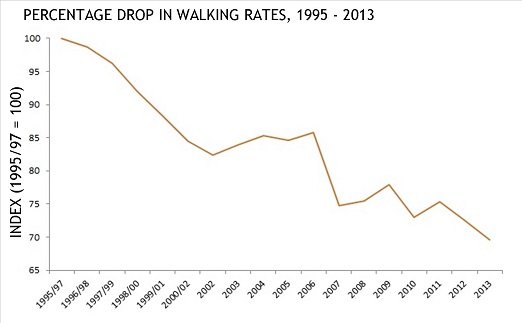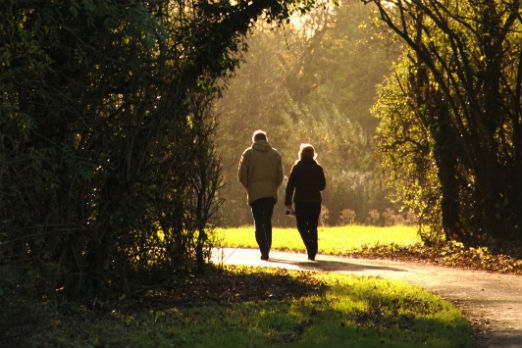But overall walking rates have seen a sharp decline over the past few decades. Between 1995 and 2013 walking trips fell from an overage of 292 per year to 2013. That is a decrease of 30%.
Index (1995/1997 = 100)

Source: Department for Transport - National Travel Survey: England, 2013
Making walking safe
England has some of the safest roads in the world, which is something to be proved of. Over the last decade the trend has been for the number of people killed or seriously injured to go down. But now is not the time to get complacent.
In 2014 the number of pedestrians killed in Great Britain rose sharply, up 12% from the year before. But more worryingly was the significant increase in deaths among more vulnerable people walking. For the over 60s the number of people seriously injured rose by 15% and those killed rose by 31%. The number of children killed rose by 12%.
| Killed | Seriously Injured | |||
| Number | % Change | Number | % Change | |
| Children: 0-15 years |
29 | 12 | 1,350 | 1 |
| Young people: 0-17 years |
40 | 14 | 1,504 | 0 |
| Adults: 18-59 years |
215 | -1 | 2,247 | -3 |
| 60 and over | 191 | 31 | 1,256 | 15 |
| All casualties | 446 | 12 | 5,063 | 1 |
Source: Department for Transport - Reported road casualties in Great Britain
These figures are unacceptable for CPRE. In order to make roads safer we have called for a number of measures that have been shown to work. These include introducing 40mph speed limits on minor rural roads and 20 mph in urban areas.
Cycling and Walking Investment Strategy
Our biggest walking success to date was securing a Cycling and Walking Investment Strategy for England as an amendment to the Infrastructure Act 2015. As a result, five year investment strategies will be introduced for walking and cycling, in the same as as they already are for rail and major roads.
Our walking vision
In CPRE’s Vision, by our centenary year in 2026 people in both town and country recognise the health benefits the countryside has to offer. Children engage much more with nature and people walk more.
This vision is not one where England’s countryside is preserved in aspic. It’s a vision of a beautiful, living - and active - countryside. This is why CPRE places such a high value on active travel, like walking.
The proximity principle
CRRE has developed the proximity principle for housing and planning. The proximity principle is the idea that:
compact cities, towns and villages produce the best social, economic and environmental outcomes.
Proximity brings people, shops, schools and healthcare closer together. It drives creativity and innovation. It means less distance to travel: people are more likely to walk or cycle, which in turn makes streets safer and more welcoming. There are environmental advantages too, with less land and energy required. Before the development of modern transport, proximity was achieved automatically. But today, it requires careful planning and intervention by government at all levels.
CPRE’s view
CPRE is campaigning for the following for walking:
- safe crossings across and paths along busier roads
- traffic management to prevent rat-running on minor roads, such as quiet lane designations and access restrictions on country lanes
- 40 mph speed limits on minor rural roads and 20 mph speed limits in built up areas and villages to improve safety
- cutting signage and other clutter, which obstructs pavements and detracts from the public realm
- investment in Rights of Way and greenways to create a vibrant network of walking routes.
But we also need a wider range of measures, including:
- 40mph speed limits on minor rural roads to improve safety
- 20mph speed limits in urban areas to improve safety
- Better use of quiet lanes in rural areas
- More effective enforcement of speed limits and other regulations, with heavier, more consistently applied penalties for those convicted of dangerous, careless and inconsiderate driving
- Communities on a human scale, where walking is easy and sprawling towns are avoided
- Developing car-free areas wherever possible




